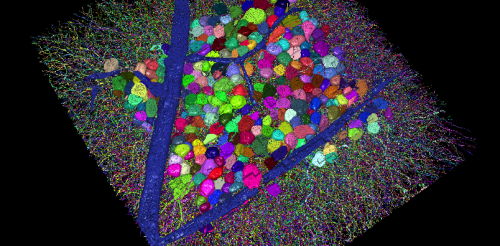How to Play
|
The Basics
- How to Play: An overview of how to play EyeWire.
- Tutorials: These videos will help you through the tutorial if you'd like further assistance.
- Player Roles: EyeWire players can advance in rankings and obtain special roles as they play.
- Competitions: Each week, there are special competitions where players can get additional points.
- The Eyewire Lexicon: Some terms used in the game that may be unfamiliar.
Some Challenges
How it Works
- F-Scores and Accuracy: How do we compute each player's accuracy score?
- The Consensus: How do we crowdsource reconstructions and determine what is the most accurate reconstruction?
|
The Neuroscience
|
- The Cell Museum: The Cell Museum is a newly released visualization platform that showcases retinal cell types reconstructed by EyeWire. In addition to providing our own classification for these neurons, we include stratification profile data for each cell. Detailed annotation of cell names can be found in the Database.
- Retinal Neuron Classification: In conjunction with the Cell Museum, we are developing a database of retinal ganglion cells in an attempt to create a comprehensive catalog of all neuronal cell types in the retina. Our hope is to collaborate with experts in the field to generate a resource that unifies current classification efforts and can be referenced for future research.
|
|
|
Ways to Get Involved
|
There are many ways to get involved in EyeWire and neuroscience research in general besides playing the game. Here are a list of options:
- Educational neuroscience material for middle/high school students: Start students early in their interest in neuroscience! Here is a list of resources for that we have found to be accessible to middle and high school students.
- EyeWire in the classroom: For teachers who want to use EyeWire in the classroom, we have developed a lesson plan around connectomics and EyeWire that you could reference.
- Contribute to our catalog of retinal neurons: Help us create a resource that consolidates existing information of retinal neuron types and literature corresponding to each.
- Image segmentation challenges: Participate in one of our challenges to improve automatic electron microscopy image segmentation.
- Work with us: EyeWire is always on the lookout for new faces to join our team. EyeWire is open to collaborations; our previous collaborators include Oculus Rift, Microsoft, and EdX, among others. Please email us if interested.
|
The Technology
|
For Science! Extras
- Neural computational models: Neural network algorithms for modeling biological brain tasks in the digital space.
- Software: Help and troubleshooting for any program used by/for Eyewire.
- For parentsː Addresses some usual queries parents may have about their child being on Eyewire.
- EyeWire Libraryː List of research papers from the 24 students of 2012's MOSTEC.
|
|




